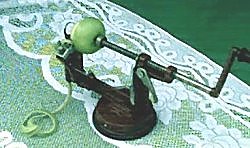 Never
do I see the crop of apples coming off but I think of Roger Miller with
laughter in his voice when he sang, "If that ain't lovin' you? Then
God didn't make little green apples...." Never
do I see the crop of apples coming off but I think of Roger Miller with
laughter in his voice when he sang, "If that ain't lovin' you? Then
God didn't make little green apples...."
These little green apples are too thick
on the branches. Therefore, the need arises to pluck two of the three
off every branch. Now that is a lot of little green apples. So then, you
will need to purchase the apple pare and coring gadget pictured. It is
absolutely the most valuable of tools.
This also brings to mind a picture of a
little aged woman
 whom
I had known all my life. She was dedicated to her family and to her
clever management in order to see they were well fed. When she was quite
elderly, I took out time to visit her one last time at her home. On her
table was setting this little gadget. When I asked her about it, she
said, "Oh! It is the most wonderful thing. I just wish I could have
had it long before now." whom
I had known all my life. She was dedicated to her family and to her
clever management in order to see they were well fed. When she was quite
elderly, I took out time to visit her one last time at her home. On her
table was setting this little gadget. When I asked her about it, she
said, "Oh! It is the most wonderful thing. I just wish I could have
had it long before now."
One could not help but reflect on the many hours she had stood with a
knife paring the apples she put up into jars in one way or another. Here
is one delicious way to save the little early green apples coming off
the tree.
APPLE MARMALADE
8 cups cooking apples, sliced (the tool makes it easy)
1 ½ cups water
5 cups sugar
2 Tablespoons lemon juice
1 orange
1. Peel, core and thinly slice enough
cooking apples to measure 8 cups of sliced fruit.
2. Bring water and sugar to boil,
stirring until all sugar is dissolved.
3. Add lemon juice, apples, and orange
thinly sliced and slivered. Boil rapidly until the mixture reaches 211
degrees. (Water boils at 212 degrees F.)
4. Remove from heat, skim off the foam,
ladle into eight sterilized half-pint sterilized jars and seal.
You aren't through yet:
Do not throw away the peeling and the
core. Homemade pectin is easy and fun to make:
HOMEMADE PECTIN
For each pound of fruit add two cups of
water. Cover and boil slowly for 15 minutes. Strain through a colander
saving the juice.
Return the pulp to the kettle and add the same amount of water that you
originally used. Cook again for 15 minutes, let stand for 10 more
minutes and pour through colander again, squeezing well to remove all
the juice.
Combine the two batches of juice. Refrigerate until ready to use. For
longer storage, heat to a boil pour into hot sterilized jars, and seal.
TO USE HOMEMADE PECTIN
This recipe is for a very simple jam or
jelly. Mix 2 cups homemade pectin with 2 cups fruit pulp and 2 cups
sugar. Boil slowly until the mixture reaches 221 degrees, the jelling
point at sea level.
PECTIN TEST (And here comes the Home Ec. Chemistry 101)
If you are not sure the fruit you are working with contains enough
natural pectin, try this pectin test. Add 1 teaspoon of any cooked puree
or pure juice to 1 tablespoon rubbing alcohol.
DO NOT TASTE, but watch the action between the fruit and the alcohol. If
the fruit is rich in pectin it will form a jellied mass stiff enough to
pick up with a fork. If low in pectin, it will form small flaky pieces
that cannot be picked up.
For further testing, add 1 tablespoon liquid pectin to 1 cup of cooked
fruit puree or juice. Remove 1 teaspoon, combine with 1 tablespoon
rubbing alcohol, and test again. If it still doesn't jell, add 1 more
tablespoon liquid pectin to the cup of fruit. Remove another teaspoon
and test with another Tablespoon of alcohol. BE SURE to discard the
samples tested. The alcohol contains a poison. Once you determine how
many Tablespoons of pectin you'll need per cup of fruit just multiply
that by the number of total cups of fruit used. For instance, if you had
to add 3 Tablespoons pectin to your cup of fruit before it would jell in
your sampling, then you will need 9 Tablespoons liquid pectin for 3 cups
of fruit. |

